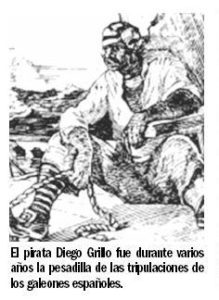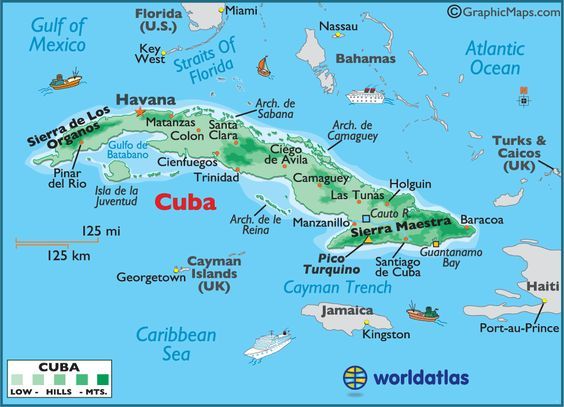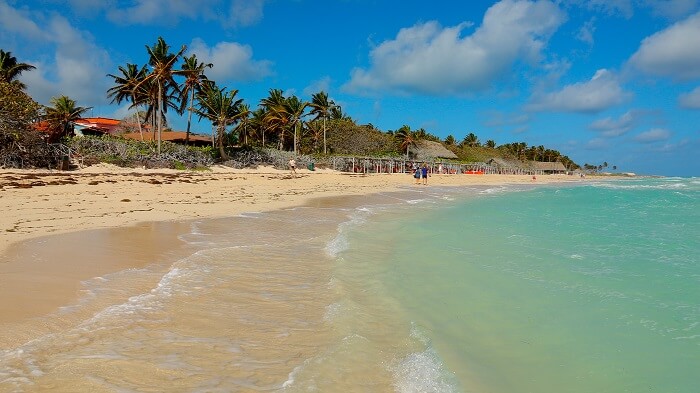DIEGO GRILLO “THE BLACK PIRATE”, A FAMOUS CUBAN CHARACTER WHO CROSSED THE SEAS
Since the end of the 16th century, pirate ships with the flags of many nations, with the famous Henry Morgan, Lorencillo, or Bartolomé the Portuguese, would sail through our seas … Since then the inhabitants of our Island would no longer have a moment of safe rest.
Many pirates, but perhaps some do not know that there was also a Cuban pirate who rubbed shoulders with the greats of that activity. Diego Grillo Trubba, the first Cuban pirate, known in his time as the “black pirate.”
To tell you about this character, we must go back to the last quarter of the 16th century, when a Spanish conqueror who was going to “Tierra Firme”, today Venezuela, as he passed through Havana, met a beautiful African slave. From this union a boy named Diego Grillo was born, born around 1554, in Havana, where he was baptized, his godfather being the Spanish captain Domingo Galván Romero.
LIFE OF CUBAN PIRATE DIEGO GRILLO
He was born a slave and raised in a very hostile environment, which caused him to escape his fate at only thirteen and flee captivity. With a strong and determined character, he joined some Spanish buccaneers who traded on the Antillean coast, with whom he acquired great skills as a sailor. But, in 1572, his life takes an unexpected turn when he is captured on the Isle of Pines by the pirate Francis Drake, who realizes the abilities of the young man, with great charisma, audacity, bravery, and an adventurous spirit.
In the company of Drake, the young Havanan will become an experienced adventurer of the sea, learning English perfectly and continuing his adventures on this pirate’s ship. Drake decides to take it under his wing and takes him with him to England. Once there, he is recruited by the English, and at only 22 years old he becomes an illustrious sailor for the Kings of England, who honored him for his contribution to his interests.
A few years later, in 1595, he returns to the waters of the Caribbean as second in command of an expedition led by Drake. Later, after Drake was named “Admiral of England”, Diego is preparing to have his own ship, with a crew made up of French, English, and Dutch, becoming the scourge of the ships of the metropolis that sailed in the Cuban seas. , a fact is known for the historical record of the campaign to capture him carried out by the Governor of Cuba, Don Juan de Maldonado Barnuevo.
Following this expedition, he temporarily abandons his ocean adventures, from which he gained not only much gold, but also fame. After a short rest, his personality and ambition lead him, in 1603, to return to his wanderings through the Antilles, accompanied on this occasion by one of the greatest and best-known pirates in history, Cornelio Jols, the terrible “Pata de Stick”.
Together they will begin a bloody stage in which they attack Spanish ships, without any interest in making slaves, since they murdered all their crew members. They even capture a convoy with eleven ships, which undoubtedly for another pirate would have been a reason for retirement to indulge in the enjoyment of the immense riches of the loot … but it did not happen that way.
DIEGO ATTACKS CUBA
In 1619 he planned and carried out an action in the bay of Nuevitas, a place where the ships loaded with gold that headed for Spain found refuge. With careful preparation of the action, Grillo surprises the caravan at the mouth of the bay, emerging gracefully and even richer from the contest. According to research and feedback on this issue, it is his last known action.
After that event, no more was ever heard of his life, but apparently, the loot was of such great magnitude that the black pirate decided to disappear from the map and leave behind him the seal that identifies him as one of the greatest pirates. that existed. Perhaps he enjoyed his countless fortune in English taverns.
Despite being terribly bloody, this did not affect his treatment as a gentleman with women, even the loser, which is demonstrated in an anecdote collected from what happened with the widow of the Governor of Campeche, Doña Isabel de Caraveo:
After having sacked that town and to avoid the common outrages to which the Spanish lady was exposed by the other pirates, Diego placed a personal guard with special care and put her on land safely, near Campeche. Doña Isabel herself is the one who recorded the fact, which confirms that, apparently, he was a true gentleman with the ladies. I do not know if I would also be grateful for any other “special” attention that I had with her on the way to Campeche …
According to another anecdote collected from this famous battle, where together with “Pata de Palo” they would attack the square with ten ships and 500 English, French and Portuguese, it is said that at the end of it and when passing among an impressive number of corpses he would find by chance that of his godfather. According to testimonies of the time, Diego showed a great feeling for the body of the one who had held him in the baptismal font.
Among other looting carried out by the most mythical of our Cuban pirates, the events in Veracruz, Cartagena, and their usual sieges of Havana are known. Although every time he assaulted her, he took the opportunity to visit and kiss his old mother, who was already a free black woman … and also caress some love that had not been forgotten.
Currently of this character and his history, we only have the existence of a “Cayo de Diego” on the northern coast of Pinar del Río, which reminds us of his fearsome presence for many years in those lands and a nocturnal establishment in Cayo Largo del Sur that bears his name.
DIEGO GRILLO “EL PIRATA NEGRO”, UN FAMOSO PERSONAJE CUBANO QUE SURCO LOS MARES
Desde finales del siglo XVI ya surcarían nuestros mares naves piratas con banderas de muchas naciones, con el célebre Henry Morgan, el Lorencillo o Bartolomé el Portugués… Desde entonces los habitantes de nuestra Isla ya no tendrían ni un momento de descanso seguro.
Piratas muchos, pero quizás algunos no conozcan que también hubo un pirata cubano que se codeó con los grandes de esa actividad. Diego Grillo, el primer pirata cubano, conocido en su época como el “pirata negro”.
Para hablarles de este personaje, debemos remontarnos al último cuarto del siglo XVI, cuando un conquistador español que se dirigía a “Tierra Firme”, hoy Venezuela, a su paso por La Habana conoce a una bella esclava africana. De esta unión nace un niño llamado Diego Grillo, nacido alrededor de 1554, en La Habana, donde es bautizado, siendo su padrino el capitán español Domingo Galván Romero.
VIDA DEL PIRATA CUBANO DIEGO GRILLO
Nace esclavo y es criado en un entorno muy hostil, lo que hizo que con solo trece años escapara de su destino y huyera del cautiverio. De carácter fuerte y decidido, se une a unos bucaneros españoles que comerciaban en el litoral antillano, con los que adquiere grandes habilidades como marinero. Pero, en 1572, su vida da un giro inesperado cuando es capturado en Isla de Pinos por el pirata Francis Drake, que se percata de las habilidades del joven, con gran carisma, audacia, valentía y espíritu aventurero.
En compañía de Drake el joven habanero se transformará en un experimentado aventurero del mar, aprendiendo perfectamente el inglés y continuando sus andanzas en la nave de este pirata. Drake decide tomarlo bajo su tutela y lo lleva consigo a Inglaterra. Una vez allí, es reclutado por los ingleses, y con solo 22 años se convierte en un ilustre marinero de los Reyes de Inglaterra, los cuales le honraban por la contribución a sus intereses.
Unos años después, en 1595, vuelve a las aguas del Caribe como segundo al mando de una expedición capitaneada por Drake. Más tarde, después que Drake fuera nombrado “Almirante de Inglaterra”, Diego se dispone a tener su barco propio, con una tripulación compuesta por franceses, ingleses y holandeses, convirtiéndose en el azote de las naves de la metrópoli que navegaban en los mares cubanos, hecho conocido por la constancia histórica de la campaña para capturarlo que realizara el Gobernador de Cuba, Don Juan de Maldonado Barnuevo.
Tras esta expedición, abandona temporalmente sus aventuras por el océano, de las que obtuvo no solamente mucho oro, sino también fama. Después de un breve descanso, su personalidad y ambición le llevan, en 1603, a regresar a sus andanzas por las Antillas, acompañado en esta ocasión por uno de los más grandes y conocidos piratas de la historia, Cornelio Jols, el terrible “Pata de Palo”.
Juntos comenzarán una sangrienta etapa en la que atacan a navíos españoles, sin interés alguno de hacer esclavos, ya que asesinaban a todos sus tripulantes. Llegan incluso a capturar un convoy con once naves, lo que sin dudas para otro pirata hubiese sido motivo de retiro para entregarse al disfrute de las inmensas riquezas del botín… pero no ocurrió así.
DIEGO ATACA A CUBA
En 1619 planifica y lleva a cabo una acción en la bahía de Nuevitas, lugar donde encontraban refugio los barcos cargados de oro que se dirigían a España. Con una cuidadosa preparación de la acción, Grillo sorprende a la caravana en la boca de la bahía, saliendo airoso y aún más rico de la contienda. Según las investigaciones y regerencias de este tema, es su última acción conocida.
Después de aquel acontecimiento, nunca se supo más de de su vida, pero al parecer el botín fue de tan grandes magnitudes que el pirata negro decidió desaparecer del mapa y dejar, tras él, el sello que lo identifica como uno de los más grandes piratas que existió. Quizás disfrutó en las tabernas inglesas de su incontable fortuna.
A pesar de ser terriblemente sanguinario, esto no afectaba su trato como todo un caballero con las mujeres, incluso del vencido, lo que queda demostrado en una anécdota recogida de lo acontecido con la viuda del Gobernador de Campeche, Doña Isabel de Caraveo:
Después de haber saqueado aquella villa y para evitar los ultrajes comunes a que estaba expuesta la dama española por los demás piratas, Diego le colocó una guardia personal con un cuidado especial y la puso en tierra sana y salva, cerca de Campeche. La propia Doña Isabel es la que dejó constancia del hecho, lo que confirma que, al parecer, era todo un caballero con las damas. No sé si además le estaría agradecida de alguna otra atención “especial” que tuviese con ella en el trayecto hacia Campeche…
Según otra anécdota recogida de esta citada famosa batalla, donde junto a “Pata de Palo” atacarían la plaza con diez navíos y 500 ingleses, franceses y portugueses, se relata que al finalizar la misma y al pasar entre un impresionante número de cadáveres encontrara por casualidad el de su padrino. Según testimonios de la época, Diego mostró gran sentimiento por el cuerpo de aquel que lo había sostenido en la pila bautismal.
Entre otros saqueos que realizó el más mítico de nuestros piratas cubanos, se conocen los acontecidos en Veracruz, Cartagena y sus habituales asedios a La Habana. Aunque cada vez que la asaltaba aprovechaba para visitar y besar a su anciana madre, que ya era negra liberta… y también acariciar algún amor no olvidado.
Actualmente de este personaje y su historia, solo nos queda la existencia de un “Cayo de Diego” en la costa septentrional de Pinar del Río, que nos recuerda su temible presencia durante muchos años por esas tierras y un establecimiento nocturno en Cayo Largo del Sur que lleva su nombre.
Agencies/ MemoriasCubanas/ Derubín Jacome/ Extractos/ Excerpts/ Internet Photos/ Arnoldo Varona/ www.TheCubanHistory.com
THE CUBAN HISTORY, HOLLYWOOD.












